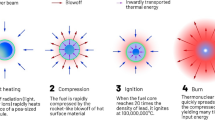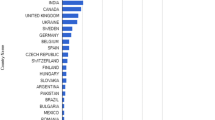Abstract
A 325-MHz continuous-wave (CW) four-vane radiofrequency quadrupole (RFQ) is employed in Injector-I of the China Accelerator-Driven Subcritical System. The radiofrequency tuning and beam commissioning were performed from January 2014 to January 2017. In a cold test, a stability study showed that the design of the segmented resonantly coupling and dipole stabilizer rods can shift the harmful quadrupole and dipole mode from the fundamental mode to above 2.6 MHz. We also found a simplified tuning method for the field unflatness, involving changing the inserted length of a few plug tuners. For achieving CW-beam commissioning, two full-size RFQs were constructed successively. The commissioning results indicate that the beam transmission rate decreased by approximately 3% as the normalized field unflatness decreased by 1%. A 10-MeV CW proton beam with an average beam current of 2.1 mA was achieved at the target of Injector-I, and the output beam energy of the RFQ was 3.18 MeV.















Similar content being viewed by others
References
J.Y. Tang, Z.H. Li et al., Conceptual physics design on the C-ADS accelerators. IHEP-CADS-Report/2012-01E (2012)
H.F. Ouyang, S.L. Pei, Physics design on C-ADS injector-1 RFQ. Prog. Rep. China Nucl. Sci. Technol. 2, 66–73 (2011)
Superfish. http://laacg.lanl.gov/laacg/services/download_sf.phtml
S.N. Fu, Software development for the RF measurement and analysis of RFQ accelerator. HEP & NP 26(7), 735–741 (2002). (in Chinese)
S.N. Fu, Study on the field tuning method of a resonantly coupled RFQ. HEP & NP 26(8), 870–875 (2002). (in Chinese)
H.F. Ouyang, S.N. Fu, Tuning and measuring of RFQ with resonantly coupled segments. HEP & NP 27(6), 551–554 (2003). (in Chinese)
H.F. Ouyang, S.N. Fu, X.L. Guan et al., Study on the design of an intense-beam RFQ with stabilization. HEP & NP 28(7), 753–757 (2004). (in Chinese)
H.F. Ouyang, T.G. Xu, X.L. Guan et al., Computer simulation study on the design of the coupling cell in an RFQ with intense beams. High Power Laser Part. Beams 15(2), 195–198 (2003). (in Chinese)
S.N. Fu, H.F. Ouyang, T.G. Xu, Study on the function of dipole stabilizer rods in an RFQ accelerator. HEP & NP 29(3), 295–300 (2005)
L.M. Young, Segmented resonantly coupled Radio-Frequency Quadrupole (RFQ), in Proceedings of PAC, Washington DC, USA (1993), pp. 3136–3138. https://doi.org/10.1109/pac.1993.309578
L.M. Young, D.E. Rees, L.J. Rybarcyk et al., High power RF conditioning of the LEDA RFQ, in Proceedings of PAC, New York, USA (1999), pp. 881–883. https://doi.org/10.1109/pac.1999.795387
E. Fagotti, L. Antoniazzi, A. Palmieri et al., High-power RF conditioning of the TRASCO RFQ, in Proceedings of LINAC, Tel-Aviv, Israel (2012), pp. 828–830
H. Shi, H.F. Ouyang, G. Wu et al., Cold measurement and CW conditioning of RFQ for China-ADS Injector-I, in Proceeding of The Eighth proseminar of Chinese Microwave and Radio Frequency Technology for Accelerator, Chendu, China (2016), pp. 6–11 (in Chinese)
Computer Simulation Technology (CST). https://www.cst.com
C.G. Yao, Electron Linear Accelerator (Scientific Press, Beijing, 1986). (in Chinese)
High Frequency Structure Simulator (HFSS). http://www.ansys.com/products/electronics/ansys-hfss
H. Shi, H.F. Ouyang, High-power RF conditioning of China ADS 325 MHz RFQ, in HPPA Mini-Workshop, Lanzhou, China (2015)
T.M. Huang, Q. Ma, W.M. Pan et al., High power input couplers for China ADS project, in HPPA Mini-Workshop, Lanzhou, China (2015)
ANSYS. http://www.ansys.com/
C. Meng, S.C. Wang, J.S. Cao et al., Beam commission of C-ADS injector-I RFQ accelerator, in Proceedings of IPAC, Richmond, VA, USA (2015), pp. 3827–3829
F. Yan, Front end commissioning for China-ADS Injector-I test facility, in ICFA Mini-Workshop on Beam Commissioning for High Intensity Accelerators, Dongguan, Guangdong, China (2015)
F. Yan, H.P. Geng, C. Meng et al., Commissioning and operation experience with the China ADS Injector-I CW linac. arXiv:1705.05068v1 (2017)
Acknowledgements
The authors acknowledge the beam-commissioning group of China-ADS Injector-I for the cooperation and help in the beam commissioning.
Author information
Authors and Affiliations
Corresponding author
Rights and permissions
About this article
Cite this article
Shi, H., Ouyang, H., Wang, S. et al. RF tuning and beam commissioning of CW RFQ for China-ADS Injector-I. NUCL SCI TECH 29, 142 (2018). https://doi.org/10.1007/s41365-018-0478-x
Received:
Revised:
Accepted:
Published:
DOI: https://doi.org/10.1007/s41365-018-0478-x




